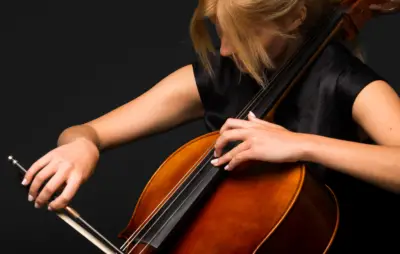Are you considering embarking on a musical journey with the elegant and melodic tones of a cello? If so, you might find yourself pondering a common question among aspiring cellists: what size cello do I need? Selecting the appropriate cello size is a crucial first step to ensure a comfortable and enjoyable playing experience.
Whether you’re a beginner or transitioning to a larger instrument, understanding the factors that determine the right cello size for you is essential. Let’s delve into the intricacies of cello sizing and discover how to make an informed decision that harmonizes perfectly with your musical aspirations.
What size cello should I choose?

Selecting the right cello size is crucial to ensure a comfortable and rewarding playing experience. The appropriate cello size is determined by your age, body size, and arm length. Here are some general guidelines to help you choose the right cello size:
- 1/10, 1/8, 1/4, 1/2, and 3/4 Size Cellos: These smaller sizes are typically recommended for young beginners, usually ranging from very young children to pre-teens. If you fall into this age group, you should consider starting with one of these sizes.
- 4/4 (Full) Size Cello: This is the standard cello size and is suitable for older children, teenagers, and adults. If you are around 12 years old or older, or if you have reached a certain height and arm length, a full-size cello might be the right choice.
How do I determine my ideal cello size?
Determining your ideal cello size involves considering your age, body measurements, and comfort while playing. Here’s a step-by-step guide to help you find the right cello size for you:
- Measure Your Arm Length: Start by standing up straight with your arms relaxed at your sides. Extend your left arm fully to the side, parallel to the ground. Measure the distance from the base of your neck (where your neck meets your shoulder) to the middle of your left palm. This measurement is a key factor in determining your cello size.
- Consider Your Age: Your age can provide a general guideline for cello sizing. Young beginners typically start with smaller sizes, while older students and adults usually use full-size cellos. Here’s a breakdown:
-
- 1/10, 1/8, 1/4, 1/2, and 3/4 Size Cellos: These are suitable for young children and pre-teens.
- 4/4 (Full) Size Cello: This is the standard size for older children, teenagers, and adults.
- Use the Arm Length Measurement: Compare your arm length measurement with the recommended cello sizes. While exact measurements may vary between sources, a general guideline is as follows:
-
- Arm length around 18-20 inches (45-51 cm): 1/10 or 1/8 size cello
- Arm length around 20-22 inches (51-56 cm): 1/4 size cello
- Arm length around 22-23.5 inches (56-60 cm): 1/2 size cello
- Arm length around 23.5-25 inches (60-64 cm): 3/4 size cello
- Arm length over 25 inches (64 cm): 4/4 (full) size cello
What factors influence the cello size I need?
Several factors influence the cello size you need. Choosing the appropriate cello size is essential for comfort, proper technique, and overall enjoyment while playing. Here are the key factors to consider:
- Arm Length: Your arm length, specifically the distance from the base of your neck to the middle of your left palm when your arm is fully extended to the side, is a critical factor. Different cello sizes are designed to accommodate various arm lengths, ensuring that you can comfortably reach the fingerboard and play with proper hand positioning.
- Age: Age is a general guideline for selecting cello sizes, especially for beginners. Younger players often start with smaller cellos and gradually move up to larger sizes as they grow. Adult beginners usually begin with a full-size cello (4/4).
- Body Size: Your overall body size, including height and build, plays a role in determining the right cello size. A larger body may require a slightly larger cello to maintain comfortable posture and reach the fingerboard effectively.
- Playing Comfort: It’s important to choose a cello size that allows you to maintain a relaxed and comfortable playing posture. The right cello size should enable you to reach the strings, fingerboard, and bow comfortably without straining your arms or hands.
- Finger Length and Hand Size: Your finger length and hand size impact your ability to reach the fingerboard and execute finger placements accurately. Choose a cello size that allows you to comfortably access all positions on the fingerboard.
- Playing Experience and Skill Level: Experienced cellists might choose cello sizes based on their playing style, repertoire, and specific preferences. For beginners, it’s crucial to start with a size that facilitates proper technique development.
- Future Growth: If you are a young player who is still growing, consider selecting a cello size that provides room for growth. This can prevent the need for frequent size upgrades as you develop your skills and physique.
- Professional Recommendations: Seeking advice from a cello teacher, music instructor, or experienced cellist can provide valuable insights into selecting the right cello size. These experts can assess your physical attributes, skill level, and musical goals to recommend an appropriate size.
- Trial and Comfort: Ultimately, the cello size that feels the most comfortable and allows you to play without strain should be your primary consideration. Trying out different cello sizes and feeling how they fit your body and playing style is crucial.
By considering these factors and seeking guidance from knowledgeable sources, you can make an informed decision about the cello size that best suits your individual needs and goals.
What’s the right cello size for my age?
The right cello size for your age depends on several factors, including your physical measurements, playing comfort, and skill level. Here’s a general guideline for cello sizes based on age groups:
Young Children (4-6 years old):
-
- Cello Size: 1/10 or 1/8
- Description: Very young beginners typically start with these smaller sizes to accommodate their smaller stature and arm length.
Children (7-9 years old):
-
- Cello Size: 1/4
- Description: As children grow, they may move up to a 1/4 size cello, allowing for continued comfortable playing and proper technique development.
Pre-teens (10-12 years old):
-
- Cello Size: 1/2
- Description: Pre-teens often transition to a 1/2 size cello, providing a suitable size for their developing bodies and longer arms.
Teenagers (13-18 years old):
-
- Cello Size: 3/4 or 4/4 (full size)
- Description: Teenagers may play on a 3/4 size cello as they continue to grow, eventually progressing to a full-size cello (4/4) once their arm length and physical development allow.
Adults (18 years and older):
-
- Cello Size: 4/4 (full size)
- Description: Most adult beginners and experienced players use a full-size cello (4/4) designed for mature players.
It’s important to note that these age ranges are approximate and can vary based on individual factors such as height, arm length, and playing ability. The best way to determine the right cello size for you is to measure your arm length and try out different cellos to assess comfort and playability.
Consulting a cello teacher, music instructor, or an experienced cellist can also provide valuable guidance tailored to your specific needs and goals.
How does my arm length affect cello sizing?

Your arm length is a key factor in determining the appropriate cello size for you. The relationship between your arm length and cello size ensures that you can comfortably reach the fingerboard and play with proper hand positioning.
Here’s how your arm length affects cello sizing:
- Comfortable Reach: Your arm length determines how comfortably you can reach the strings and fingerboard of the cello. If the cello is too large for your arm length, you might have difficulty reaching the notes accurately, which can affect your technique and playing quality. Conversely, if the cello is too small, you might experience cramped hand positions and limited finger movement.
- Proper Hand and Arm Position: Playing the cello with the correct hand and arm position is essential for producing a good tone and preventing strain or injury. A cello that matches your arm length allows you to maintain proper posture and technique, which is crucial for both sound production and long-term playing comfort.
- Ease of Shifting and Position Changes: Different pieces of music require players to shift their hand positions along the fingerboard. An appropriately sized cello makes these shifts easier and more fluid. When your arm length matches the cello size, you can navigate the fingerboard with greater ease, facilitating smooth transitions between positions.
- Preventing Overstretching or Cramping: Playing a cello that is too large for your arm length can lead to overstretching your fingers and hand, causing discomfort and potentially hindering your progress. On the other hand, a cello that is too small may lead to cramped hand positions, affecting your ability to execute complex passages.
- Long-Term Playing Comfort: Selecting a cello size that matches your arm length contributes to long-term playing comfort. Proper ergonomics and a comfortable playing posture are essential for enjoying your practice sessions and avoiding unnecessary strain or injury.
To determine the appropriate cello size based on your arm length, measure the distance from the base of your neck to the middle of your left palm when your arm is fully extended to the side.
Compare this measurement to the recommended cello sizes provided by experts or cello teachers. Keep in mind that while arm length is a crucial factor, other considerations, such as your age and body size, also play a role in choosing the right cello size for you.
Can adults play smaller-sized cellos?
Yes, adults can play smaller-sized cellos, but it’s important to consider several factors before making that decision. Smaller-sized cellos, such as 3/4 or 7/8 sizes, are typically designed for younger players with smaller body proportions. However, there are instances where adults might choose to play a smaller cello:
- Physical Comfort: Some adults may have smaller body frames or arm lengths that make playing a full-size cello uncomfortable. In such cases, a smaller-sized cello could provide a more comfortable playing experience.
- Medical Considerations: Adults with certain medical conditions or physical limitations might find it more manageable to play a smaller-sized cello, which could help prevent strain or discomfort.
- Transitioning from Another Instrument: If you’re transitioning from another instrument to the cello and find a full-size cello challenging initially, starting with a smaller size might facilitate the learning process.
- Travel Convenience: Smaller cellos are more portable and easier to travel with, which might be advantageous for adult players who are frequently on the move.
What size cello is suitable for a child beginner?
The size of a cello suitable for a child beginner depends on the child’s age, arm length, and physical build. Cellos come in various sizes, typically ranging from 1/16 to full size (4/4). Here’s a general guideline based on age and height:
- 1/10 Cello: Typically suitable for children around 3-5 years old with an arm length of about 14-16 inches (36-41 cm).
- 1/8 Cello: Suitable for children around 4-6 years old with an arm length of about 16-18 inches (41-46 cm).
- 1/4 Cello: Suitable for children around 5-7 years old with an arm length of about 18-20 inches (46-51 cm).
- 1/2 Cello: Suitable for children around 7-10 years old with an arm length of about 20-22 inches (51-56 cm).
- 3/4 Cello: Suitable for children around 10-12 years old with an arm length of about 22-24 inches (56-61 cm).
- 4/4 (Full Size) Cello: Typically suitable for ages 12 and older, but it’s important to note that some younger or smaller-statured players might switch to a full-size cello earlier. This size is suitable for players with an arm length of 24 inches (61 cm) or more.
It’s crucial to have the child try out different cello sizes under the guidance of a knowledgeable teacher or professional before making a decision.
Playing a cello that’s too large or too small can hinder proper technique and hinder the child’s learning progress. A cello teacher or an experienced instrument specialist will be able to help you determine the best size for your child based on their individual characteristics.
How does cello size impact playing comfort?

The size of a cello has a significant impact on playing comfort, particularly for beginners and younger players. Choosing the correct cello size is crucial to ensure that the player can comfortably hold and play the instrument without straining their body. Here’s how cello size can impact playing comfort:
- Arm Length and Reach: A cello that is too large for a player can lead to discomfort and strain. Young players with shorter arms may struggle to reach the correct positions on the fingerboard, leading to awkward hand and arm angles. This can result in poor technique and potential discomfort or even injury.
- Body Size: A cello that is too large can be difficult for a smaller-statured player to manage. It may require them to stretch their arms excessively, which can cause strain in the neck, shoulders, and back. On the other hand, a cello that is too small might cause a player to hunch over or cramp their posture.
- Balance and Control: The weight and balance of the cello matter for playing comfort. If the cello is too heavy or unbalanced, it can strain the player’s arms and shoulders, making it difficult to maintain proper bowing and fingering control.
- Bow Arm Angle: The size of the cello affects the angle at which the player’s bow arm approaches the strings. If the cello is too large, the bow arm may be forced into an uncomfortable angle, making it challenging to produce a good tone and control the bow.
- Reaching for Pegs and Fingerboard: If a player has difficulty reaching the pegs for tuning or the lower end of the fingerboard, it can lead to strained wrist positions and hinder overall playing comfort.
- General Posture: Playing a cello that is an appropriate size promotes a more natural and balanced posture. This helps in maintaining good spinal alignment, reducing strain on muscles, and preventing potential musculoskeletal issues.
Choosing the right cello size for a player is crucial for establishing proper technique, preventing discomfort or injury, and fostering a positive learning experience. It’s recommended to consult with a cello teacher or a knowledgeable instrument specialist who can assess the player’s physical characteristics and recommend the most suitable cello size for their comfort and long-term progress.
What are the drawbacks of using an incorrect cello size?
Using an incorrect cello size can lead to several drawbacks and negative consequences for a player, particularly for beginners and younger musicians. Here are some of the drawbacks of using an inappropriate cello size:
- Poor Technique Development: Playing a cello that is too large or too small can hinder the development of proper technique. The player may struggle to maintain correct hand positions, fingerings, and bowing angles, which are essential for producing a good tone and playing with precision.
- Physical Discomfort: Incorrect cello sizing can lead to physical discomfort, strain, and even injury. Players may experience discomfort in the neck, shoulders, arms, and back due to awkward posture and excessive stretching. Over time, this discomfort can discourage practice and hinder progress.
- Limited Range of Motion: An ill-fitting cello can restrict the player’s range of motion, making it difficult to execute advanced techniques and musical passages. This limitation can impede the player’s musical expression and creativity.
- Inefficient Practice: Playing on an incorrect cello size can lead to frustration during practice sessions. The player may find it challenging to produce the desired sound, leading to decreased motivation and less effective practice.
- Intonation Issues: Inaccurate cello sizing can make it harder to accurately place fingers on the fingerboard, leading to intonation problems. This can negatively impact the player’s ability to play in tune and develop a good ear for pitch.
- Limited Repertoire Development: A player using an incorrect cello size might struggle with more complex pieces of music. This limitation could hinder their ability to progress to more challenging repertoire and musical styles.
- Reduced Confidence: Continuously struggling with an ill-fitting cello can erode a player’s confidence and self-esteem. This can have long-term effects on their enjoyment of playing the instrument and their overall musical development.
- Risk of Injury: The strain caused by playing on an incorrect cello size can lead to musculoskeletal injuries, such as tendonitis, muscle strain, and joint pain. These injuries may require medical attention and rest, leading to interruptions in practice and progress.
To avoid these drawbacks, it’s crucial to ensure that a player, especially a beginner or a child, is using the correct cello size. Seeking guidance from a cello teacher or a knowledgeable instrument specialist will help in selecting the appropriate size that promotes proper technique, comfort, and a positive learning experience.
Recommended:
Conclusion
You can always get the right information on what size cello do I need. Choosing the right size cello is essential for a comfortable and effective learning experience, particularly for beginners and younger players.
Selecting an appropriate cello size based on the player’s age, arm length, and physical build is crucial to promote proper technique, prevent discomfort or injury, and foster musical progress. Consulting a cello teacher or an experienced instrument specialist will ensure that the chosen cello size optimally supports the player’s musical journey and helps them develop a strong foundation for future growth.


